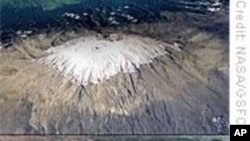<!-- IMAGE -->
For some years now, dramatic before-and-after pictures have shown a decline in the glaciers on Tanzania's Mount Kilimanjaro. But now, researchers have combined those photographic surveys with actual measurements of the ice taken on the mountain.
In a report published Tuesday, researchers say the melting on Kilimanjaro is accelerating and that in a few years there may be no ice left.
"Between the period of February 2000 to February 2009, we have lost over 50 percent of the ice thickness at a rate of 0.54 meters per year," said Prof. Lonnie Thompson of Ohio State University. "If you would project that into the future, that ice field will disappear sometime before 2018."
Thompson is the lead author of the study, which appears in the Proceedings of the National Academy of Sciences. He says that as the ice thins and the glaciers divide, the ice is lost at a faster and faster rate.
"It makes it more vulnerable in that the ice fields are breaking up. The Furtwängler Glacier divided two years ago into two sections, and those sections are now in the process of dividing. And when they divide, they expose the darker crater floor underneath them, which means more [heat] radiation is absorbed, and so we expect to see an acceleration in the rate that that ice disappears."
Thompson and his colleagues studied ice cores, which are cylinders drilled out of the glacier from top to bottom. Thompson says they represent almost 12,000 years of history, since the glaciers first formed on Kilimanjaro. He says the top, most recent layer shows evidence of melting and refreezing, in the form of elongated air bubbles – a pattern that is not seen at any other time in the glaciers' history.
"So in the 11,700-year history, we don't find that type of melting having been preserved, and it would be preserved and you should be able to see it in the bubble structure," he said in an interview.
As the glaciers melt away, Thompson suggests the change in the mountain's appearance may have a direct impact on people who live near Kilimanjaro.
"There's 30,000-40,000 tourists that go to that mountain every year. And the government of Tanzania and the parliament, they have discussed, how many people are going to come to Kilimanjaro when those ice fields do disappear."
Lonnie Thompson of Ohio State University says that the phenomenon of glacial melting can be seen elsewhere in the tropics – in South America, Indonesia, and elsewhere in Africa. He writes that the pattern suggests that the cause is rooted in global climate change, rather than local conditions.





